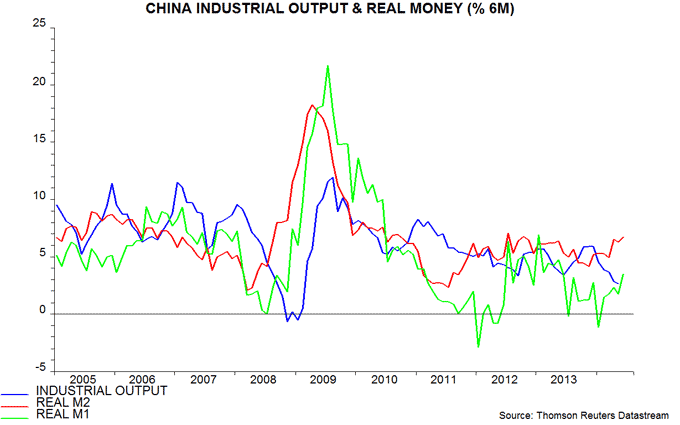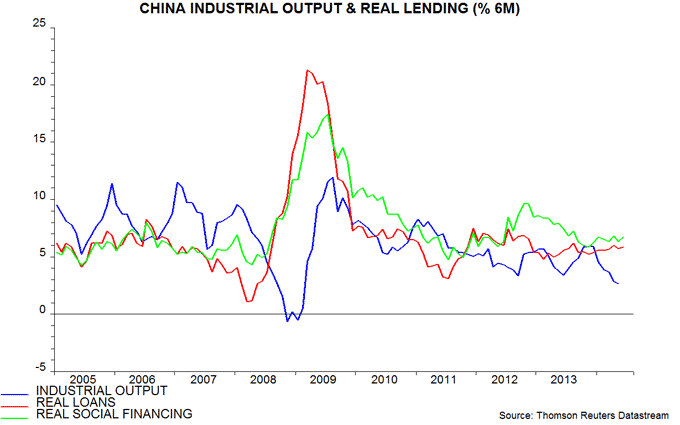Entries from July 13, 2014 - July 19, 2014
Why Eurozone economic news should improve
The Citi Eurozone economic surprise index has been negative since the spring but the balance of news may now improve, based on an expected revival in global activity and respectable narrow money trends. Growth, however, will probably lag other regions.
The industrial sector has lost momentum since early 2014. The new orders component of the manufacturing purchasing managers’ survey declined steadily between January and June, though remains in expansion territory. Industrial output fell by 1.1% in May to stand 1.0% lower than six months earlier*.
The slowdown mainly reflects global trends. Six-month growth of global industrial output has fallen since November 2013, reaching an 11-month low in May. In addition, the euro trade-weighted exchange rate has been stable at a strong level, while real money expansion has been lower in the Eurozone than in the US / UK, suggesting less of a cushion from expanding domestic demand.
Global real money trends and leading indicators, however, are signalling a near-term pick-up in activity – see previous post. US and Chinese purchasing managers’ new orders indices have strengthened and typically lead the Eurozone measure – see first chart. Equity analysts’ earnings forecast revisions, which correlate with the new orders measure, have recovered – second chart.
Eurozone real narrow money expansion, which signalled the 2011-12 recession and subsequent recovery, has fallen but remains at a level historically consistent with moderate economic growth – third chart. The latest reading, for May, predates the ECB’s recent easing package. The last ECB quarterly bank lending survey, conducted in April, reported that SME credit conditions were expected to loosen further, also suggesting respectable output prospects – fourth chart**. (The next survey is scheduled for release on 30 July.)
Are current banking problems in Portugal symptomatic of monetary / economic deterioration across the periphery? Country narrow money data actually show relative strength in Portugal recently but weakness in Ireland and Greece – fifth chart. Real money is growing moderately in Italy and Spain, suggesting limited downside economic risk.
*May weakness was probably exaggerated by holiday effects, which should unwind in June.





UK inflation firming on schedule
Previous posts extending back to last summer argued that the trend in UK inflation would shift from down to up in spring 2014 in lagged response to faster monetary growth and associated economic strength. The higher-than-expected June number reported today is consistent with the forecast but recent volatility suggests waiting for July data before concluding that the trend has turned.
Annual consumer price inflation fell from 1.8% in April to 1.5% in May but rebounded to 1.9% in June. Some commentators argue that the June rise is a blip that will be reversed in July; the preferred view here, by contrast, is that May was the outlier, with June representing a return to trend.
“Blip” proponents attribute the June rise to a delayed start to summer sales, particularly for clothing and footwear. Annual clothing and footwear inflation of 2.4% in June, however, compares with an average of 1.3% over the prior 12 months. Even if all of this difference reflects a sales timing effect, the implied boost to CPI inflation is less than 0.1 percentage points*.
The focus here is on “core” inflation, i.e. excluding energy and unprocessed food and adjusted for VAT changes and the 2012 jump in undergraduate tuition fees. This rose to 2.0% in June, the highest since September. The chart below, an update from a post in August 2013, shows that major turning points in core inflation over the past decade have followed trend changes in broad money expansion roughly two years earlier, consistent with the Friedmanite rule. The rule suggests a further move higher through early 2015, at least.
*Clothing and footwear has a 7.1% weight in the CPI basket.
Chinese money trends signalling solid H2 economy
Chinese monetary statistics for June suggest that economic growth will rise through end-2014.
A post two months ago noted that monetary trends had turned positive and were signalling a summer revival in economic momentum, following a slowdown in early 2014. This forecast has received support from stronger purchasing managers’ surveys in May and June and should be confirmed by June industrial output released tomorrow.
The monetary backdrop, meanwhile, has improved further: six-month expansion of real (i.e. inflation-adjusted) M2 and M1 rose to 20- and 13-month highs respectively in June – see first chart. Allowing for the typical half-year lead, the economic growth upswing should last through end-2014, at least.
Real credit trends have also firmed modestly, although the broad “total social financing” measure is still growing more slowly than a year ago – second chart.
The monetary pick-up partly reflects policy easing in response to a softening property market and below-target inflation – market interest rates have been on a gently declining trend since end-2013. Policy-makers may move to the sidelines if the economy firms as expected and house price inflation stabilises – likely based on the historical relationship with monetary trends.



